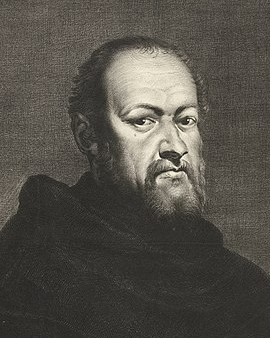Sebastiano del Piombo, actually Sebastiano Luciano, was a famous Italian Renaissance painter. He received the epithet del Piombo only at an advanced age, when he was given the office of papal seal-keeper, a piombatore. Nothing is known of his birth, childhood, or parents. He may have been born in Venice about 1485. When he is about 20 years old, Venetian society knows and loves him as a virtuoso lute player. He is also trained in painting by the famous painter Giovanni Bellini and also has close contact with the slightly older Giorgione, also a former pupil of Bellini.
Even in Sebastiano del Piombo's early works, a very distinctive artistic profile is evident that does not attempt to copy Bellini or Giorgione.... Piombo often paints massive larger-than-life figures, monumental, with vivid colors and impressive lighting. Good examples from his first creative period are his winged altarpiece for the church of San Bartolomeo di Rialto and the high altarpiece for the church of San Giovanni Crisostomo.
Thus, the young painter came to the attention of the banker Agostino Chigi, in his time one of the most influential men in Italy, banker to the Popes, patron and patron of artists and men of letters, and in 1511 he took him to Rome, where he was to decorate Chigi's magnificent villa with mythological frescoes. At the same time, the famous painter Rafael was also working in the villa and both were vying for greater success. Rafael was the winner, so to speak, but Sebastiano del Piombo also received much recognition. Nevertheless, he later took his final leave of fresco painting, preferring to create portraits on canvas. Contemporaries considered him the greatest portrait painter in Italy and gave him the nickname "felix pictor" (happy painter). His most famous portraits from this creative period are the paintings of Pope Clement VII, the writer Pietro Aretino and the captain of the "Andrea Doria".
During this period he also met the famous artist Michelangelo. To him he also owed many commissions from influential Romans. In 1527, however, a caesura occurred in Sebastiano del Piombo's life. Rome was attacked and partially devastated by Spanish, German and Italian mercenaries. The painter was locked up in the Vatican's Castel Sant'Angelo for four weeks with the Pope and his men, many Vatican works of art destroyed. The sensitive artist del Piombo found it very difficult to cope with the events, he became depressed and this can also be seen in his late work, which consisted mainly of gloomy, melancholy motifs. He turned more to music and poetry and developed special painting techniques, for example on slate or on marble, because he hoped that works of art on this material could not be destroyed so easily. This even led to a falling out with Michelangelo. Sebastiano del Piombo died in Rome in 1547.
×





.jpg)
.jpg)
.jpg)
.jpg)
.jpg)
.jpg)
.jpg)
.jpg)
.jpg)
.jpg)
.jpg)
.jpg)
 - (MeisterDrucke-94201).jpg)
 - (MeisterDrucke-94201).jpg)
.jpg)
.jpg)
.jpg)
.jpg)
 c1526 - (MeisterDrucke-89862).jpg)
 c1526 - (MeisterDrucke-89862).jpg)
 (1478-1534) Pope from 1523 until 1534 - (MeisterDrucke-127153).jpg)
 (1478-1534) Pope from 1523 until 1534 - (MeisterDrucke-127153).jpg)
.jpg)
.jpg)
.jpg)
.jpg)
.jpg)
.jpg)
.jpg)
.jpg)
.jpg)
.jpg)
.jpg)
.jpg)
.jpg)
.jpg)
.jpg)
.jpg)
.jpg)
.jpg)
.jpg)
.jpg)
.jpg)
.jpg)
.jpg)
.jpg)
.jpg)
.jpg)
.jpg)
.jpg)
.jpg)
.jpg)
.jpg)
.jpg)
.jpg)
.jpg)
.jpg)
.jpg)
.jpg)
.jpg)
 - (MeisterDrucke-101303).jpg)
 - (MeisterDrucke-101303).jpg)
.jpg)
.jpg)
.jpg)
.jpg)
.jpg)
.jpg)
 - (MeisterDrucke-129302).jpg)
 - (MeisterDrucke-129302).jpg)
.jpg)
.jpg)
.jpg)
.jpg)
.jpg)
.jpg)
.jpg)
.jpg)
.jpg)
.jpg)
.jpg)
.jpg)
.jpg)
.jpg)
.jpg)
.jpg)
.jpg)
.jpg)
.jpg)
.jpg)
.jpg)
.jpg)
.jpg)
.jpg)
.jpg)
.jpg)
.jpg)
.jpg)
.jpg)
.jpg)
.jpg)
.jpg)
.jpg)
.jpg)
_1510_-_(MeisterDrucke-383823).jpg)
_1510_-_(MeisterDrucke-383823).jpg)
.jpg)
.jpg)
.jpg)
.jpg)
.jpg)
.jpg)
.jpg)
.jpg)
.jpg)
.jpg)
.jpg)
.jpg)
.jpg)
.jpg)
.jpg)
.jpg)
.jpg)
.jpg)
.jpg)
.jpg)
.jpg)
.jpg)
.jpg)
.jpg)
.jpg)
.jpg)
.jpg)
.jpg)
 - (MeisterDrucke-43390).jpg)
 - (MeisterDrucke-43390).jpg)
.jpg)
.jpg)
.jpg)
.jpg)
.jpg)
.jpg)
.jpg)
.jpg)
.jpg)
.jpg)
.jpg)
.jpg)
.jpg)
.jpg)
.jpg)
.jpg)






